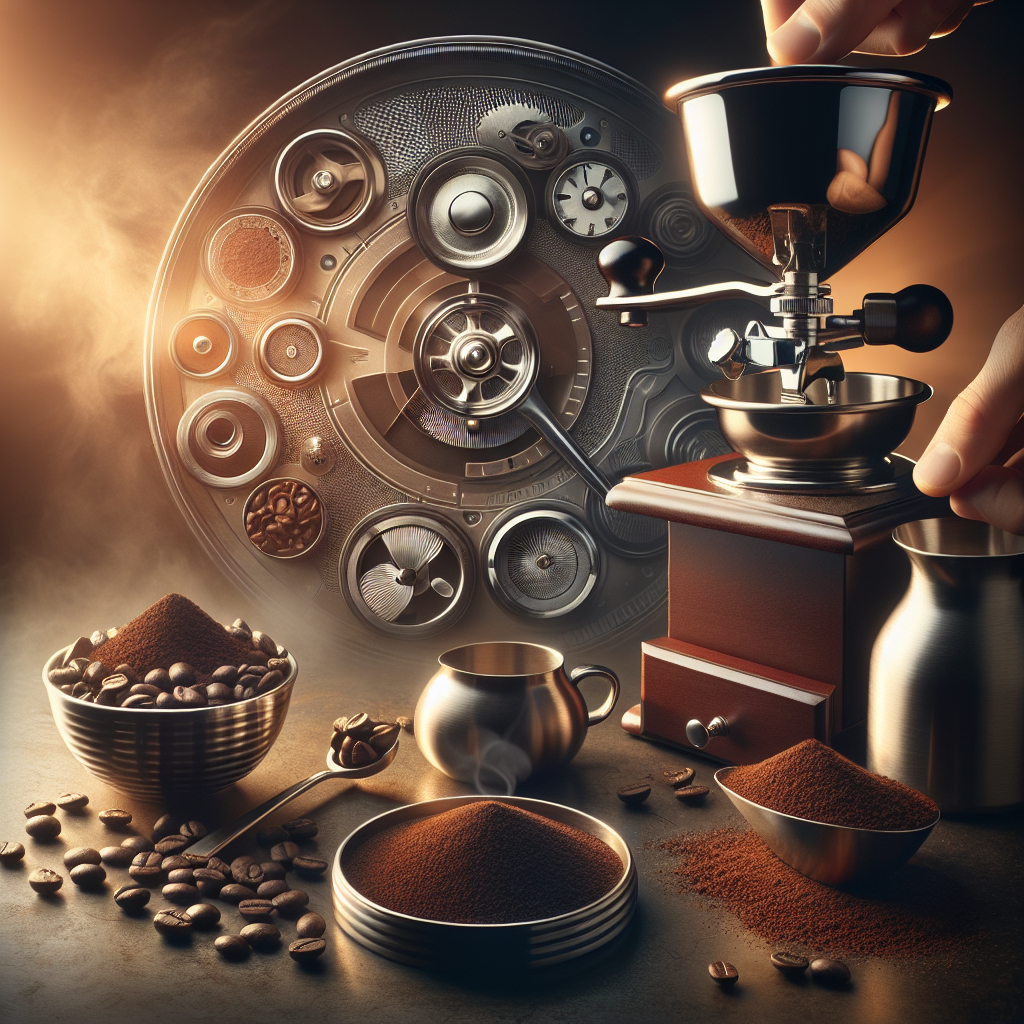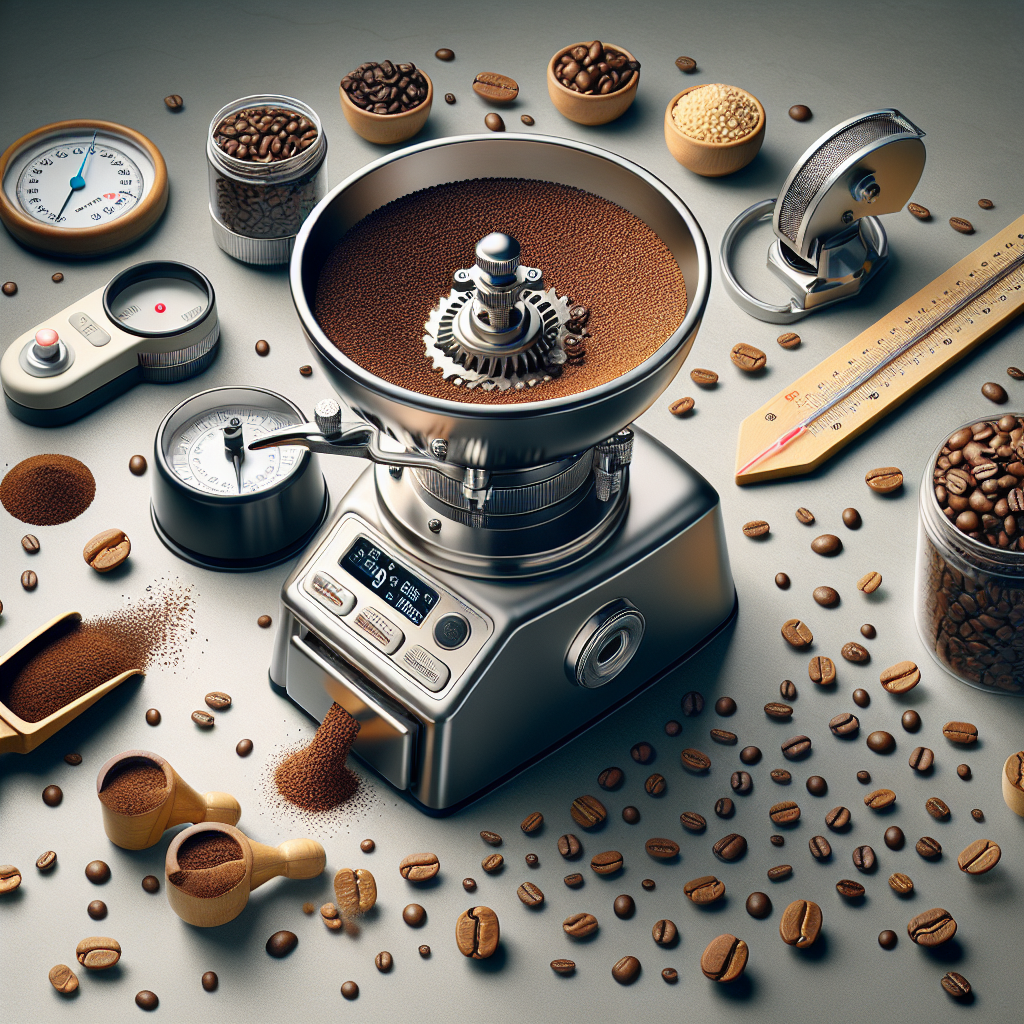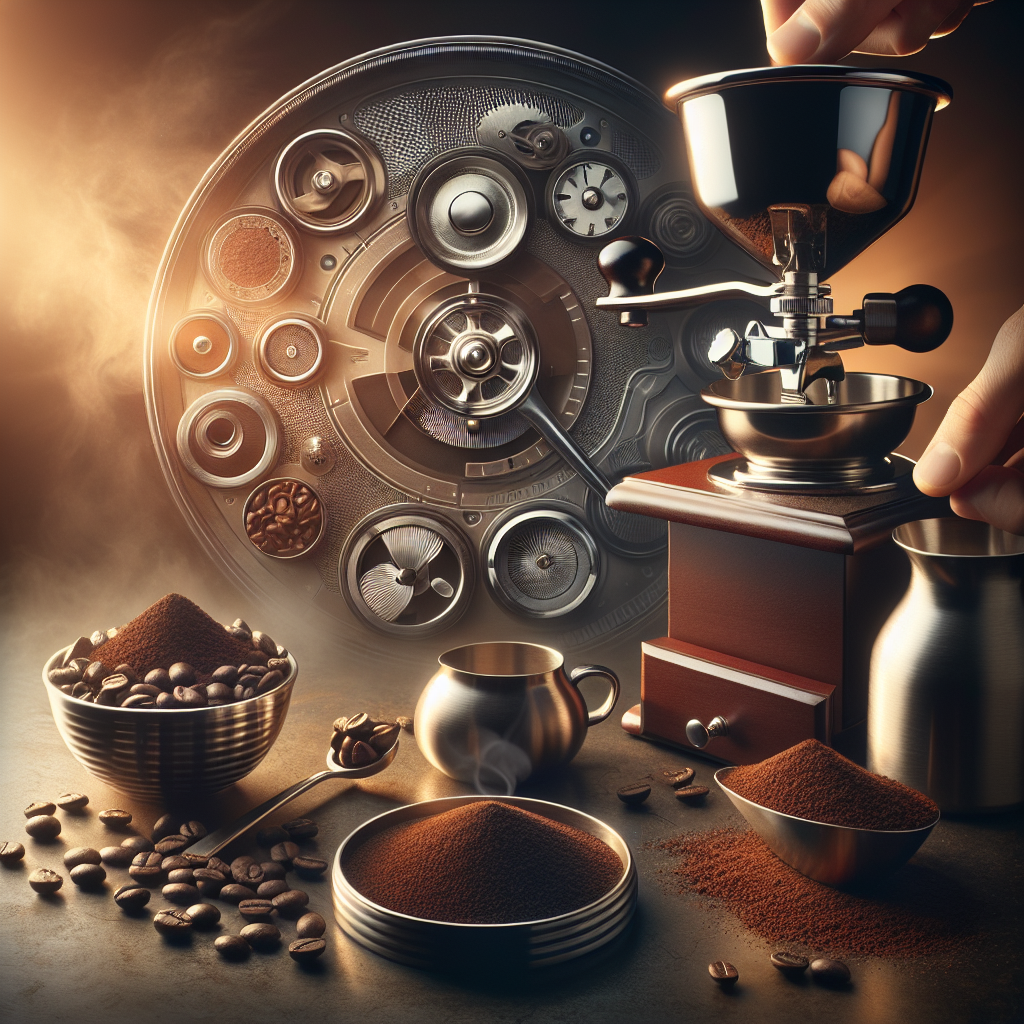Are you a coffee lover eager to perfect your espresso-making skills? Look no further than “The Ultimate Guide To Understanding The Grinding Process For Espresso Beans.” In this comprehensive guide, we will explore the intricate art of grinding espresso beans, unlocking the secrets to achieving that perfect cup of joe. From understanding the different grinding methods to exploring the impact of grind size on flavor profiles, this guide will equip you with all the knowledge you need to take your espresso-making game to the next level. So grab your favorite mug and get ready to embark on a caffeine-fueled journey like no other!

The Importance of Grinding for Espresso
Why is grinding important for espresso?
Grinding plays a crucial role in brewing the perfect espresso shot. When you grind your coffee beans, you are breaking them down into smaller particles, increasing their surface area. This increased surface area allows for better extraction of flavors and aromas when hot water is passed through the grounds. Without proper grinding, you won’t be able to unlock the full potential of your espresso beans.
How does grinding affect the flavor of espresso?
The grind size directly impacts the flavor profile of your espresso. The finer the grind, the more surface area is exposed to the water, resulting in a quicker extraction and a stronger, more intense flavor. On the other hand, a coarser grind will slow down the extraction process, producing a milder and less concentrated espresso. Achieving the perfect grind size is essential to achieving the desired flavor balance in your espresso shot.
Types of Grinding Machines
Burr grinders
Burr grinders are considered the gold standard for espresso grinding. They consist of two abrasive surfaces, known as burrs, that grind the coffee beans between them. Burr grinders offer superior consistency in grind size, resulting in more even extraction and a better-tasting espresso. They are available in both manual and electric variants, depending on your preference and budget.
Blade grinders
Blade grinders, on the other hand, use rotating blades to chop the coffee beans into smaller pieces. While they are widely available and more affordable than burr grinders, they are not recommended for grinding espresso. Blade grinders tend to produce an inconsistent grind size, which can result in uneven extraction and a subpar espresso experience. It is best to invest in a burr grinder for optimum results.
Manual grinders
For those who appreciate the old-world charm and enjoy a hands-on approach, manual grinders provide an excellent option. These grinders require physical effort to turn the grinding mechanism and allow for greater control over the grind size. While they may not offer the convenience of electric grinders, manual grinders are often favored by espresso enthusiasts who value the art of the brewing process.
Choosing the Right Grinder
Considerations for selecting a grinder
When choosing a grinder for your espresso journey, there are several factors to consider. First, consider your budget. Grinders can range from affordable options for beginners to high-end models used by professionals. Next, think about the desired grind size range you need for your preferred espresso brewing method. Finally, consider the available space in your kitchen and whether you prefer a manual or electric grinder. Taking these factors into account will help you narrow down your options and find the perfect grinder for your needs.
Budget-friendly options
If you’re just starting your espresso brewing journey or have a limited budget, there are several budget-friendly grinder options available. Manual burr grinders such as the Hario Skerton or the Porlex Mini are often recommended for their affordability and decent grind consistency. Electric burr grinders like the Baratza Encore or the Capresso Infinity are also popular choices for their quality and wallet-friendly price tags. These grinders offer a good entry point into the world of espresso grinding without breaking the bank.
High-end options
For those who are passionate about achieving the ultimate espresso experience, high-end grinders are worth considering. These grinders often feature advanced technologies, precise grind size adjustments, and superior build quality. Some notable high-end options include the Mazzer Mini, the Baratza Sette, and the Eureka Atom. Investing in a high-end grinder ensures greater control over your grind size, resulting in exceptional espresso shots that will impress even the most discerning coffee connoisseurs.
Understanding Grind Size
The role of grind size in espresso extraction
Grind size is a critical parameter that affects the rate of extraction during the brewing process. For espresso, the optimal grind size allows for the right balance of flavors and aromas to be extracted within a specific timeframe. If the grind size is too fine, the water may struggle to pass through the compacted coffee grounds, resulting in a bitter and over-extracted shot. Conversely, if the grind size is too coarse, the water may pass through the grounds too quickly, leading to a weak and under-extracted espresso. It is essential to find the ideal grind size to achieve the perfect extraction and the desired flavors in your cup of espresso.
Ideal grind size for espresso
The ideal grind size for espresso is often described as a fine, powdery consistency similar to table salt. This fine grind allows for the water to evenly extract the flavors and aromas from the coffee grounds, resulting in a balanced and full-bodied espresso. Achieving the right grind size may require some trial and error, as different beans and brewing equipment may have varying requirements. It is recommended to start with a standard espresso grind size and make adjustments based on taste until you reach your preferred flavor profile.

Grinding Techniques
Doser vs. doserless grinders
When it comes to espresso grinding, you may come across two main types of grinders – doser and doserless grinders. Doser grinders feature a chamber that collects and dispenses a predetermined amount of ground coffee. This can be convenient for commercial settings or when grinding large quantities at once. Doserless grinders, on the other hand, grind the coffee directly into the portafilter, eliminating the need for a separate dosing chamber. Doserless grinders offer greater flexibility in terms of grind size adjustments and are often favored by home espresso enthusiasts for their precision and ease of use. Ultimately, the choice between a doser and doserless grinder depends on your specific needs and brewing routine.
Stepped vs. stepless grinders
Another aspect to consider when selecting a grinder is whether it is stepped or stepless. Stepped grinders have pre-determined grind settings that allow you to adjust the grind size within a set range. These grinders offer ease of use and repeatability, making them suitable for beginners or those who prefer a straightforward approach. Stepless grinders, on the other hand, provide infinite grind size adjustments, allowing for precise tuning to achieve the perfect extraction. This level of control is often preferred by experienced baristas or espresso aficionados who want to fine-tune their brewing process.
Grinder Settings and Adjustments
How to adjust the grinder settings
Adjusting the grinder settings is an essential part of dialing in your espresso. Different factors, such as the type of beans, roast level, and ambient humidity, may require adjustments to achieve the desired extraction. Most grinders have a dial or a collar that allows you to adjust the grind size. To make adjustments, start by grinding a small amount of coffee at the current setting, brew a shot, and taste the results. If the shot is over-extracted or tastes bitter, coarsen the grind; if it is under-extracted or tastes weak, make the grind finer. Continue this iterative process until you achieve the desired flavor balance in your espresso.
Determining the right grind setting
Finding the right grind setting may take some time and experimentation, but a few guidelines can help you get started. If your espresso shot extracts too quickly (under-extracted), meaning it flows out too fast and has a weak taste, try grinding finer. On the other hand, if the shot extracts too slowly (over-extracted) and takes longer to pour, resulting in a bitter taste, try grinding coarser. Remember that each adjustment should be made incrementally, as even small changes can significantly impact the extraction and flavor of your espresso. With practice and patience, you will gradually hone your skills and find the perfect grind setting for your preferences.
Maintaining Your Grinder
Regular cleaning and maintenance
To ensure optimal performance and longevity of your grinder, regular cleaning and maintenance are essential. The coffee oils and residue that accumulate over time can affect the flavor of your espresso and even clog the grinding mechanism. It is recommended to clean the grinder’s burrs and chambers every few weeks. Most grinders provide instructions on disassembling and cleaning the components. Additionally, regularly brushing the burrs and using a grinder cleaning tablet or rice can help remove any built-up residue. Proper maintenance will not only improve the flavor of your espresso but also extend the lifespan of your grinder.
Replacing grinder burrs
Over time, the burrs in your grinder may wear down or become dull, affecting the grind consistency and overall performance. It is recommended to replace the burrs periodically, depending on your usage and the manufacturer’s recommendations. Burr replacement is a more advanced maintenance task that may require specific tools and knowledge. If you’re unsure about replacing the burrs yourself, it is best to consult the grinder’s user manual or seek assistance from a professional technician. By regularly inspecting and replacing the burrs, you can ensure that your grinder continues to produce consistent and high-quality grounds for your espresso.
Troubleshooting Common Grinding Issues
Uneven grind distribution
One common issue you may encounter when grinding for espresso is uneven grind distribution. This can result in an uneven extraction and a less-than-ideal espresso. To address this problem, consider using a distribution tool or WDT (Weiss Distribution Technique) to evenly distribute the grounds in the portafilter before tamping. These tools help break up clumps and ensure a more even extraction. Additionally, make sure to check if your grinder’s burrs are properly aligned and not experiencing any issues that could affect grind consistency. By taking steps to address uneven grind distribution, you can achieve a more balanced and flavorful espresso.
Grinder overheating
Grinder overheating can occur when grinding a large quantity of coffee consecutively or when using a grinder with limited heat dissipation capabilities. Overheating can affect the taste of your espresso and even lead to damage to the grinder’s internal components. To prevent overheating, give your grinder occasional breaks during extended grinding sessions to allow it to cool down. If you frequently grind large quantities of coffee, consider investing in a grinder with enhanced heat management features or choosing a grinder specifically designed for high-volume use. By ensuring proper ventilation and avoiding excessive heat buildup, you can maintain the flavor integrity of your espresso and prolong the lifespan of your grinder.
Experimenting with Different Grind Profiles
Using coarser or finer grinds for different espresso extraction methods
Adjusting the grind size allows you to experiment with different espresso extraction methods. For example, if you enjoy a longer, milder espresso shot, try using a coarser grind. This will slow down the extraction process, resulting in a less concentrated and more balanced cup. Conversely, if you prefer a shorter, more intense espresso shot, opt for a finer grind. This will increase the extraction speed, creating a bolder and more robust flavor profile. By exploring different grind profiles, you can discover new dimensions of taste and tailor your espresso experience to your preferences.
Exploring single-origin beans and different roast profiles
Another exciting aspect of grinding for espresso is the opportunity to explore different coffee beans and roast profiles. Single-origin beans from specific regions offer distinct flavors and characteristics that can elevate your espresso experience. Experimenting with different origins, such as Ethiopian, Colombian, or Brazilian, can provide a glimpse into the diverse world of specialty coffee. Additionally, varying roast profiles, from light to dark roasts, can significantly influence the flavor profile of your espresso. Lighter roasts tend to highlight the nuanced acidity and fruity notes, whereas darker roasts bring out bittersweet flavors and fuller body. By combining different beans and roast profiles with precise grinding, you can create a truly unique and personalized espresso experience.
Tips and Tricks for Consistent Grinding
Weighing beans for consistent dosing
To ensure consistent dosing and replicate the same flavor profile in each espresso shot, weighing your coffee beans before grinding is crucial. By using a digital scale, you can accurately measure the desired amount of coffee for each shot. Consistent dosing allows for better control over the extraction process and helps avoid variations in strength and flavor. Additionally, weighing your beans helps in determining the correct grind-to-dose ratio, ensuring that you achieve the desired extraction time and flavor balance consistently.
Warming up the grinder before use
Before starting your espresso grinding session, it’s essential to warm up the grinder. This is especially important for burr grinders that can retain heat from previous grinding sessions, resulting in inconsistent grind sizes. By running the grinder for a few seconds without any coffee beans, you ensure that the internal parts reach the optimal temperature. This helps maintain the consistency of the grind size and guarantees a more accurate and repeatable extraction. Warming up the grinder only takes a few moments and is a small step that can make a significant difference in the quality of your espresso.
In conclusion, grinding is a fundamental step in the espresso brewing process. It not only affects the flavor and character of your espresso but also allows you to explore a wide range of possibilities and create your perfect cup. Understanding the importance of grinding, choosing the right grinder, mastering grind size, and adopting proper techniques and maintenance practices will significantly enhance your espresso journey. With practice, patience, and a passion for exploring different grind profiles, your espresso brewing skills will flourish, and you’ll be able to savor exceptional, café-quality espressos in the comfort of your own home.

